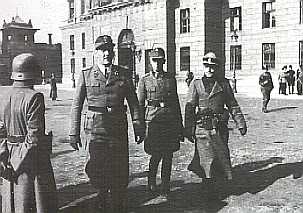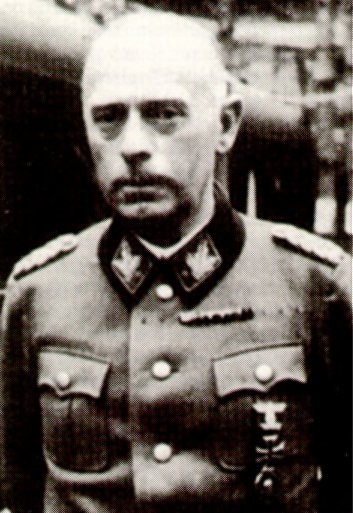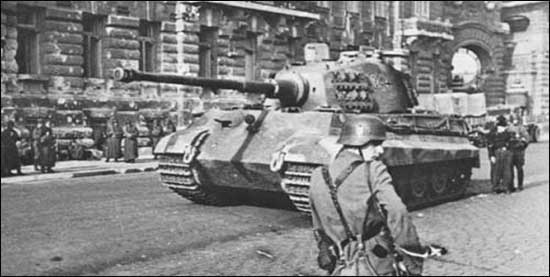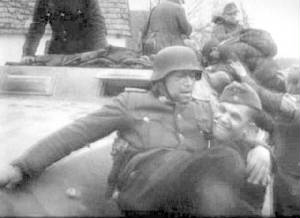|
Coup d'etat in Budapest
Disaster that
struck German in Balkan in 1944 made Hungary tottering too. It didn't a surprise: since Stalingrad, the Hungarians had been
withdraw theirs troops from the front line and practically become a neutral country
in the rear of the German front, a land of night-clubs and white bread, where the privileged could live without rationing
or conscription. As a pragmatic people, the Hungarians aware that the Allied will be won. So, in October 1944 the Hungarian
government of Admiral Horthy attempted to follow Romania and Bulgaria examples to leave the sinking ships.
Unfortunately,
Hitler had been prepared for such treachery and there were sufficient German units in Hungary to prevent a disaster. Hitler's
distrust to his Balkan allies made him decided that as far as possible the Hungarian and the Romanian divisions must replaced
by the Volksdeutsche (the racial Germans) of those countries, who had been conscripted into the Waffen SS. This gave
the SS a far more important role than they had fulfilled on the eastern and western fronts.

|
| Otto Skorzenny in Budapest after the Nazi coup d'etat. |
While the Red Army only less than 100 miles from Budapest, Horthy
figured it was of last time to surrender in payment for political considerations. To stop this treachery, Hitler sent a well-known
SS-Sturmbannfuehrer Otto Skorzenny and a special parachute-battalion to Budapest to bring Hungarian leaders back in line.
Skorzenny moved quickly. He kidnapped Horthy's son who tried
to make agreement with Tito's Yugoslavian partisan and sends an ultimatum to his father to surrender. Meanwhile, SS-Obergruppenfuehrer
Dr. Otto Winkelmann,
the HSSPF Hungary, had taken control of Budapest. To threatening rumble of 40 German tanks, SS-Untersturmfuehrer Kernmayr
occupied the Budapest radio station and proclaimed the new pro-Nazi regime. Skorzenny also alerted 22.Freiwilligen-Kavalleriedivision der SS 'Maria Theresa' which cordoned off all approaches to the Burgberg, Horthy's
fortress and then attacked that place. Horthy surrenders and offered his abdication. Ferenc Szalasi, the leader of the pro-Nazi
Arrow Cross party, replaced him.
The Unternehmen Panzerfaust--as the coup d'etat operation named--raise the Waffen-SS prestige in Hitler's eyes. But the victory was a short
live. The sequel to the operation was a Stalingrad for them.
The Birth of the Disaster
On October 20, 1944 the Red Army under Marshal Malinovski captured Debrecen in eastern Hungary. Then, on Stalin's order, Malinovski initiated the attack on Budapest
on October 29, 1944. On November 3, the first Soviet tanks rolled into Vecsés, Kispest
and reached Ferihegy airport. But the Russian advance in Hungary, though rapid at first, was
then slowed down by very stiff German and Hungarian resistance, especially the incoming German reinforcements.
To stop the Red Army advance,
'Maria Theresa' Division was sending to southeastern of Budapest defense ring at Dunaharztil and Taksony. On November 5, they
were attacked by Soviets at Karola Positions. The division throws back the attackers and then mounted counterattack.

|
| SS-Oberstgruppenfuehrer Karl von Pffefer-Wildenbruch |
Another Waffen-SS division
was sending to defend the Budapest, 8.SS Kavelleriedivision 'Florian Geyer'. The
division was a veteran of many combat missions on the Eastern Front. On November 1944, they were assigned as part of Budapest
garrison. When Soviets reach Ocsa on November 3, the Germans forced back due to Hungarian units routing on their flanks. 'Florian
Geyer' was send to counterattacks and succeeded to recaptures Vesces and Ullo.
But the Waffen SS divisions
success was a short live. On November 20, Soviets force a breach between the 'Maria Theresa' and the 1st Honved Cavalry Division, which endangers the Budapest suburbs. 'Maria Theresa' losses was great and on December
1944, the division strength only 8,000 men. All divisional units sent to Budapest to act in the city's defense, leaving their
horses behind. As a result of this,
more than 30,000 horses were left wandering around Budapest, and many ended up providing
essential nourishment for the inhabitants and the army.
To defend the Hungarian capital, Hitler send the IX.Waffen-Gebirgs-Korps der
SS under SS-Oberstgruppenfuehrer Karl von Pffefer-Wildenbruch. This corps included 'Maria Theresa' and 'Florian Geyer';
another five supporting battalion from Waffen SS; a regiment SS-Police; two panzer division from German army; with another
supported battalion; plus remnants of several Hungarian divisions. On December 11,
von Pffefer-Wildenbruch establishes
his HQ on Castle Hill - the governmental center of the Hungarian capital. The Corps itself has at most 70 armored vehicles.
Hitler and Szalasi decided at their meeting early in December to hold Budapest at "any cost". Why? First of all, Hitler
hoped to retain Hungarian oil fields, the last one that he still has for his industries and motorized units. Secondly, the
Hungarian capital was an important point to defend Austria's frontiers. Lastly, for Hitler personally, Budapest still has
a large Jewish community and he eager to exterminate all of them for his Final Solution.
On 14 December, the Red Army had
begun a terrible pounding of German positions in Budapest on both sides of the Danube. That very night twelve thousands guns
angled at forty-five degrees and amassed all round the Hungarian capital, were fired simultaneously.
The darkness dissolved in apocalyptic
flashes as the twelve thousands guns began to pulverize the city in a deluge of steel.
Then at dawn on 22 December, the
Cossack cavalry struck. Three thousand heavy tanks and fifteen infantry divisions hurled themselves at Budapest.
On Christmas Eve, 1944, Russian
tanks burst into the suburbs of Buda - on the west side of the Danube; Pest was on the east. These were from the spearheaded
of Marshal Tolbulkhin's Third Ukrainian Front, which had pushed across the Danube
below the Budapest. Although the German's Tiger tanks succeeded to stop them, Tolbulkhin increased the pressure from the south
while Malinovsky's Second Ukrainian Front was crossing the Danube above Budapest. On December 27 the two great forces met
in Esztergom in west of the city. The Germans had therefore lost the defense line of the Danube and the IX.Waffen-Gebirgs-Korps der SS were encircled, together with 800,000
civilians.
Budapest Pocket The actual street
combat in Budapest started simultaneously with the complete surrounding of the city on December
24. Battles fought for cities and towns usually differ from conventional warfare. Surrounded
by large buildings, orientation becomes difficult, defense is easier. Central control often ceases and small
cells operate independently. The commanders of units not larger than 50-250 soldiers become responsible
for setting the direction of combat. The significance of heavy artillery diminishes in favor of hand-to-hand
combat. While an open field battle usually ends with the rapid collapse of the enemy, the agony of city
battles can drag on for weeks and months.

|
| A German Königstiger in Budapest. |
After heavy fighting
against the Soviets, SS units pull back to Buda on the west bank of the Danube river. "Kampfgruppe Portugall" stationed Adlerberg
(Sas-Hegy) and Buda with 88mm guns. Hitler personally concerns himself with the aerial resupply of the city. Ultimately 73
DFS230-type gliders from Luftflotte 4 attempt to resupply the trapped garrison, but only 43 land successfully
On December 25, Pfeffer-Wildenbruch named commander of all military units in Budapest
pocket, replacing HSSPF Dr. Otto Winkelmann. "At best, one could say that Budapest was being led by a politician", said Heer
General Hermann Balck, commenting on Pfeffer's mediocre military abilites. Hitler orders Pfeffer-Wildenbruch to hold out at
all costs so that Soviet forces will be diverted from advancing to the Hungarian oil fields.
Meanwhile, Budapest experienced a continuous and gradual withdrawal of
the defending troops. However, the situation in Buda was quite different: the front barely moved a
few hundred meters at a time. The defending troops were vulnerable on Városmajor,
Rózsadomb and Sas-hegy, yet their stations at the Farkasrét cemetery were especially lethal to the attacking Soviet
troops. The SS soldiers took over the crypts, dug up the graves, threw out the coffins and with things looted
from the neighboring houses, set up their positions. Later, many met their death in this cemetery.
Initially,
it was possible to repel the heavy Soviet artillery because the German troops were
well supplied with a large number of small arms. Furthermore, the defenders'
small number demanded unorthodox tactics that took advantage of the terrain. This was referred to
as "chess-board" tactics: the defenders held their positions at the various villas of the area.
The Buda hills were scarcely populated at that time, houses were 50 or more meters away from each
other. This was to the advantage of the German troops: while they were forced to retreat from the attackers,
the Soviets were often caught in the undefended areas in between the houses. They were then
fired at from the villas and sharpshooters prevented reinforcements from reaching them. Although this amounted
almost to blasphemy for those who held orthodox views on military strategy, this practice worked well even for
poorly trained and poorly armed troops who could use their creativity and knowledge of terrain to
their advantage.
Given the special characteristics
of the Buda hills, even when the Soviets advanced and the front retreated back to Alkotmány street, adventurous
Hungarian units carried out diversionary actions in Ráth György street and
Városmajor. Again, this was possible only because the now Soviet positions were concentrated
around various houses and there was no continuous front line. By this time, both the German-Hungarian
and Soviet troops were decimated. Thus the terrain and the distribution of
buildings gave rise to guerilla-type warfare on both sides.
But Soviet troops enjoyed
a numerical superiority fifteen to one. Wave after wave of Sturmovik assault aircraft all but scraped the rooftops. The Germans
faced the Red Army attack with a grim determination. To prevent their encirclement a bitter battle was fought south and west
of the city shortly before Christmas. Each district, street and building were fought for beneath a shower of high explosives
and incendiaries. Fruitless opposition was waged from a succession of ruined houses.
The Soviet High Command wanted
to capture Budapest as soon as possible. On the 29th of December, with the consent of Stalin, they called upon the German-Hungarian
garrison to surrender. The Soviets send a delegation to German lines. The offer was rebuffed and on their return to Soviet lines the negotiators were
killed when their jeep is machine gunned or hits a mine (accounts differ) The Soviet news agency TASS labels the incident
a serious war crime. Soviet troops encircling Budapest will offer no quarter and the fate of the defenders became grim.
The
Failed Counter-attack
To save his troops in Budapest, Hitler, without consulting
his Chief of Staff, ordered SS-Obergruppenfuehrer Herbert Gille's IV.SS-Panzer-Korps
to leave the severely threatened Warsaw front and move four or five hundred miles south to Lake Balaton.
The counter attack
(named as Operation Konrad) began on New Year's day. First phase of the operation started by a German's
surprise attack without artillery preparation at Pilis heights and Gerecse launched against the 4th Guards Army. Then,
a drive from Komarno towards Ezstergom and along the railways to Buda developed, led by
Gille's 'Totenkopf' and 'Wiking' panzer divisions, supported by an infantry division. They made attack after attack
in effort to find a weak spot in the Soviet defenses.
On January 7, the Germans started the second phase
of Konrad. It begins with 'Wiking' attempt to continue the advance in a more northeasterly direction.
After heavy-attacks, Tolbulkhin was forced to evacuate Ezstergom. However, the Germans progress became more slowly. That
made Hitler furious and calling the operation "utterly pointless".
Gille, under increasing pressure from Himmler and General
Balck of the Fourth Army, forced his men to move on. After heavy fighting, on January 11, 1945 Gille's force reached
Budapest airport and the rescue of forty-five thousands German soldiers, half of them fellow SS men, seemed assured.

|
| SS soldiers from 'Maria Theresa' Division during the Battle of Budapest. |
But fate seem didn't sided with the poor Budapest
garrison. Although Gille's men was within 21km of Budapest and the corps signals units can hear the desparate pleas
of the garrison on the radios and can see the distant spires of the city in their field glasses, Hitler calls off the
operation. He have another idea.
General Balck hoped to surround ten Russian divisions
north of the lake. Hitler supported the General and switches the attack 70 miles to south in third phase of Konrad. So,
Gille's corps was withdrawn to Balck's sector.
However, It was a tactical error, for Russian resistance
stiffened. By the end of January, after suffers 51 senior SS officers KIA and 157 WIA and an estimated 7,000 men are
casualties, Gille's Corps got order to call off their's attack and abandoned the relief efforts. Thus, the fate of Budapest
garrisons had been sealed off.
To the Bitter
End
On January 10, Malinovski continued his advance on Pest
and cleared eight city districts with the help of Rumanians who had switched sides. This was achieved mainly by hand-to-hand
fighting because the Red Army did not want to endanger the city's waterworks with all-out bombing or artillery barrage.
On January
15, IX.Waffen-Gebirgs-Korps der SS radios Army Group South: "Artillery munitions are all used up....fuel
is at an end. The supply situation is critical. The position of the wounded is catastrophic." The Luftwaffe managed to successfully
drop only six tons of supplies to the garrison that night.
Early in
the morning of January 17 the defenders of Pest retreated into Buda across the Danube. The Hungarian soldiers refused to blow
up their historic bridges; they said that the ice over the Danube was thick enough to hold tanks, anyway. The Germans replied
that it was no time for history and blew up the bridges themselves.
The defenders fate become worst. The wounded soldiers has already surpassed of combatants.
All non-combatant troops of corps sent to front lines while military decorations parachuted into the pocket in an effort to
raise morale. But it is clear that the fate of the defenders has already sealed. On January 30, the Corps send a message to
Hitler: "The people have lost all hope."
On February 5, the Red Army captures Adler Hill. The surviving 88mm guns
of Kampfgruppe Portugall withdrawn to the Castle Hill/government center area. The SS Corps have over 11,000 wounded in pocket. Hungarian troops begin to desert to Soviets.
By February
11, the battle for the west side of the river had turned into a bitter siege. Securely entrenched in Buda's hills, German-Hungarian
troops shelled any attempts to cross the ice-covered Danube. But the 70,000 defenders were trapped on a pocket roughly one
kilometer long and one kilometer deep; other Russian forces were closing in from the west.
Explosive bullets and phosporus tumbled onto the defenders,
who refused even to contemplate defeat. The Russians eventually had little to do but mop up the bodies.
The German commander in Buda, Pfeffer von Wildenbruch, ordered
his men to try and break through the Soviet ring in three separate groups. It was obvious that there was almost no chance
of escaping, but few objected. It was better to die fighting than to be exterminated. The odds for escape were even slimmer
than imagined. The Red Army commander knew all about the breakout and was already covertly withdrawing his men from the first
buildings surrounding the German-Hungarian troops.
As the three groups were about to move off in different
directions, Russian rockets began blasting the recently evacuated buildings. Nevertheless, they surged out of their hiding
places armed only with machine pistols and met a withering wall of rocket and artillery fire. Most of them were cut down in
the first few minutes. The others kept coming, desperately trying to break through. Those surviving the rockets and artillery
were met by such masses of Russian infantrymen that it seemed impossible for single man to survive, let alone escape; but
in the darkness and confusion almost 5000 German-Hungarians filtered through.
The SS members were among the most desperately men to escape.
The Russian especially hates them and didn't have any doubt to kill the SS men on the spot. Hungarian lieutenant Gyula Litterati
told after the war how four of his SS friends that captured by Russians were forced to naked before a line of Red Army soldiers
who laughing at some jokes. Then, almost casually, the Russians fired theirs SS prisoners.
Of Pfeffer-Wildenbruch's 70,000 men, little more than 700
escaped to the German lines. They included 170 men of the 'Florian Geyer' Division, whose commander, the thirty-four-year-old
Joachim Rumohr committed suicide during the sortie after he had been wounded. Most of the rest SS men were killed in battle
or murdered, including SS-Brigadefuehrer August Zehender, the commander of 'Maria Theresa' Division.
On 13 February all resistance in Buda ceased with the surrender
of SS-Oberstgruppenfuehrer Pfeffer-Wildenbruch. During the siege, which had last seven weeks, some 50,000 German-Hungarian
troops had been killed and a few thousands made prisoners. Three Waffen SS divisions
- 'Florian Geyer', 'Maria Theresa', and a new SS Hungarian's cavalry division, the 33.Waffen-Kavalleriedivision
der SS (ungarische Nr. 3) - plus some supporting units destroyed. The IX.Waffen-Gebirgs-Korps der SS was written off from the SS units' list. Budapest had become a Stalingrad for the
Waffen SS.
|



